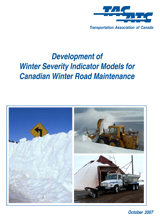This report discusses the development of a TAC Winter Severity Index. (For report purposes, a winter severity index is defined as a measure of the relative impact of winter weather on winter road maintenance (WRM) operations using historical meteorological or Road Weather Information System (RWIS) data.)A set of models were developed using Canadian WRM, Meteorological Service of Canada (MSC) and RWIS data. WRM data were collected from across Canada from eight provincial road authorities and seven cities. Salt usage in tonnes (salt (t)/lane-km/day) was chosen as the dependent variable, standardized to account for differences in road network and the number of days in the observation period. The first model developed, based on MSC data alone, achieved a goodness of fit of 0.54. Explanatory variables were based on snowfall occurrence, air temperature, freezing rain occurrence, and an east-west dummy variable to account for differences in winter road maintenance practices in different parts of Canada. A second model was developed based on MSC data together with RWIS data. This achieved a goodness of fit of 0.60, but was based on a significantly smaller sample size.
Calibration factors were developed for twenty different homogeneous groupings across Canada using the Bayesian method. Based on the calibration, thirteen of the twenty groups achieved a better goodness of fit compared to the national model results.
The report is accompanied by a spreadsheet designed to calculate the winter severity index using Environment Canada data.
Download the spreadsheet (Excel) →


